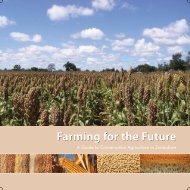Restoring the Soil - Canadian Foodgrains Bank
Restoring the Soil - Canadian Foodgrains Bank
Restoring the Soil - Canadian Foodgrains Bank
You also want an ePaper? Increase the reach of your titles
YUMPU automatically turns print PDFs into web optimized ePapers that Google loves.
10Existing Green Manure/Cover Cropping Systems Around The Worldtropics) has been greatly underestimated. High rainfall and substantial slopes onagricultural land create ideal conditions for erosion to occur. Rain drops hitting bareground cause soil particles to be dislodged. These are transported downhill in waterflow, and pick up more soil as momentum builds. But covered soil is less vulnerableto water erosion. One study showed that farmers cultivating maize and mucuna onhillsides with a 35% slope and more than 2,000 millimetres of annual rainfall innor<strong>the</strong>rn Honduras are actually increasing <strong>the</strong> productivity of <strong>the</strong>ir soil year by year,without using any o<strong>the</strong>r soil conservation practices. Their soils are totally protectedfrom erosion because <strong>the</strong>y are covered by mucuna 10 months of <strong>the</strong> year. 68. Improved soil moisture. The soil cover, or mulch, that is provided by a gm/cc alsogreatly improves drought resistance. The gm/cc residues add organic matter to <strong>the</strong> soil,which increases infiltration of water into <strong>the</strong> soil and increases <strong>the</strong> water-holdingcapacity of <strong>the</strong> soil. In one experiment carried out during a drought in sou<strong>the</strong>rnHonduras, maize fertilized with chemical fertilizer died one month into <strong>the</strong> drought,maize fertilized with animal manure died about two months later, and maize fertilizedwith jackbean still managed to produce a ra<strong>the</strong>r small harvest.9. Zero tillage. The experience of hundreds of thousands of farmers in Brazil,Paraguay, Argentina and Honduras shows us that after two to four years of heavyapplications of organic matter from gm/ccs (over 50 MT/ha, green weight), farmerscan move to zero-till systems that retain very high levels of productivity. A tremendousamount of time and effort is saved when farmers no longer need to plow <strong>the</strong>ir soil.Using mucuna, zero tillage and no chemical fertilizer, smallholder farmers working onhillsides in nor<strong>the</strong>rn Honduras have maintained yields of maize of over 2.5 MT/ha forover 30 years. They achieve maize yields of 4 MT/ha with very small additional applicationsof urea. Their cost of producing each sack of maize is about 30% less than thatof <strong>the</strong> richer farmers nearby who use tractors, chemical fertilizers and herbicides, andhave flat land. 7In Brazil, farmers who use gm/ccs combined with rotations and medium applicationsof chemical fertilizer regularly harvest 7 to 8 MT/ha of maize without having tilled <strong>the</strong>soil in over 10 years. 810. Competitiveness with farmers using tractors. Gm/ccs are very effective in smo<strong>the</strong>ringweeds. They can also allow farmers to move to zero tillage. Since <strong>the</strong> primarymethod used in conventional agriculture for achieving both weed control and soilpreparation is tillage, farmers who use tractors have traditionally had a huge advantageover smallholder farmers who cannot afford tractors. Now, by using gm/ccs, smallholderfarmers using animal traction or hoes and sometimes even those working on6Buckles, Daniel, et al., Cultivos de Cobertura en Agricultura de Laderas, Innovación Campesina con Mucuna (Ottawa:Centro Internacional para el Mejoramiento de Maíz y Trigo and Centro Internacional de Investigaciones para elDesarrollo, 1998).7Flores, Milton and Nicolas Estrada, “Estudio de Caso, La Utilizacion de Frijol Abono (Mucura spp.) Como AlternativaViable para el Sostenimiento Productivo de Sistemas Agricolas del Litoral Atlantico.” Paper presented to <strong>the</strong> Center forDevelopment Studies at <strong>the</strong> Free University of Amsterdam, 1992.8Bunch, Roland, “El Trabajo de EPAGRI en el Estado de Santa Catarina, Brasil, Nuevas Posibilidades Importantes paraAgricultores de Escasos Recursos.” No date, unpublished.
















